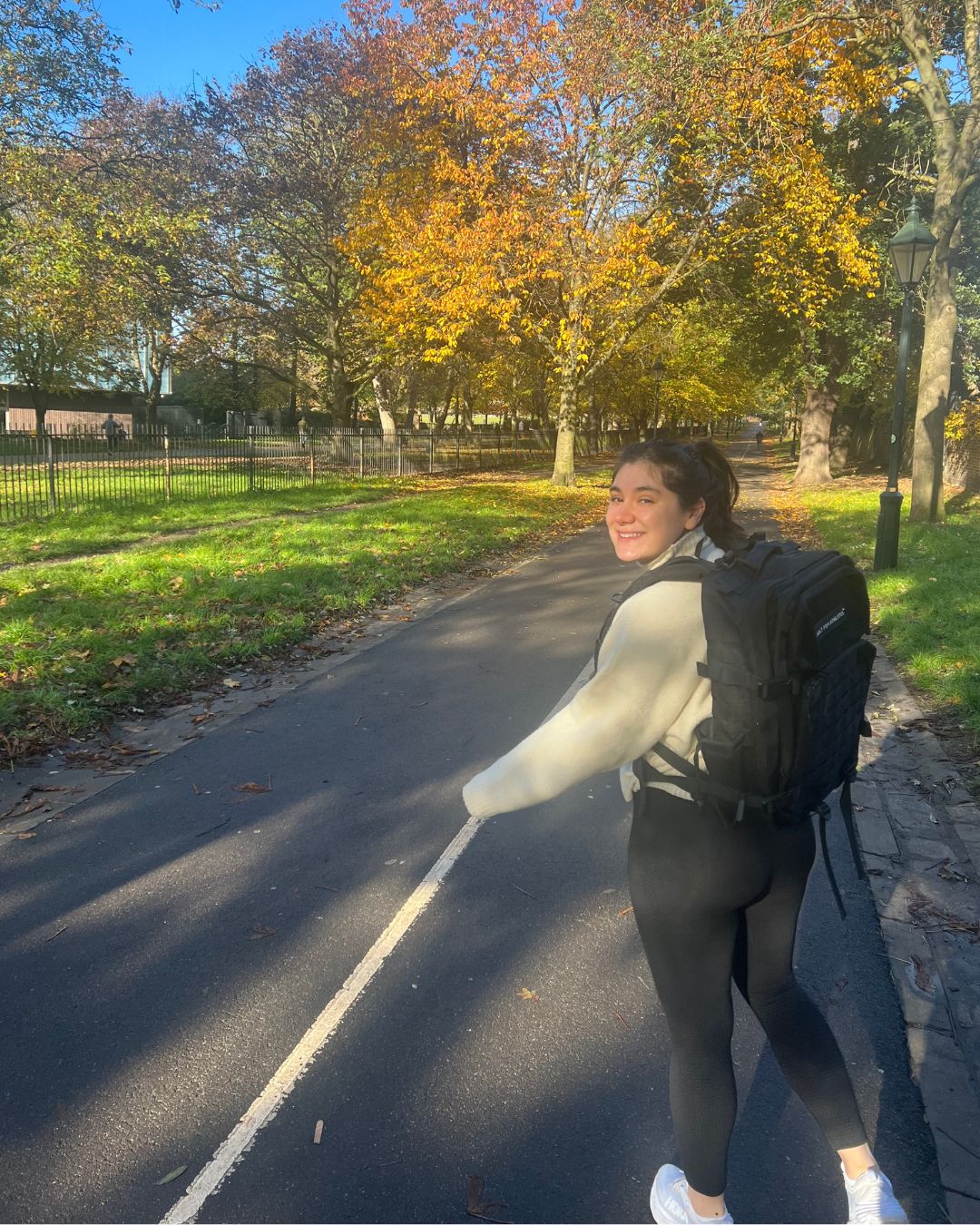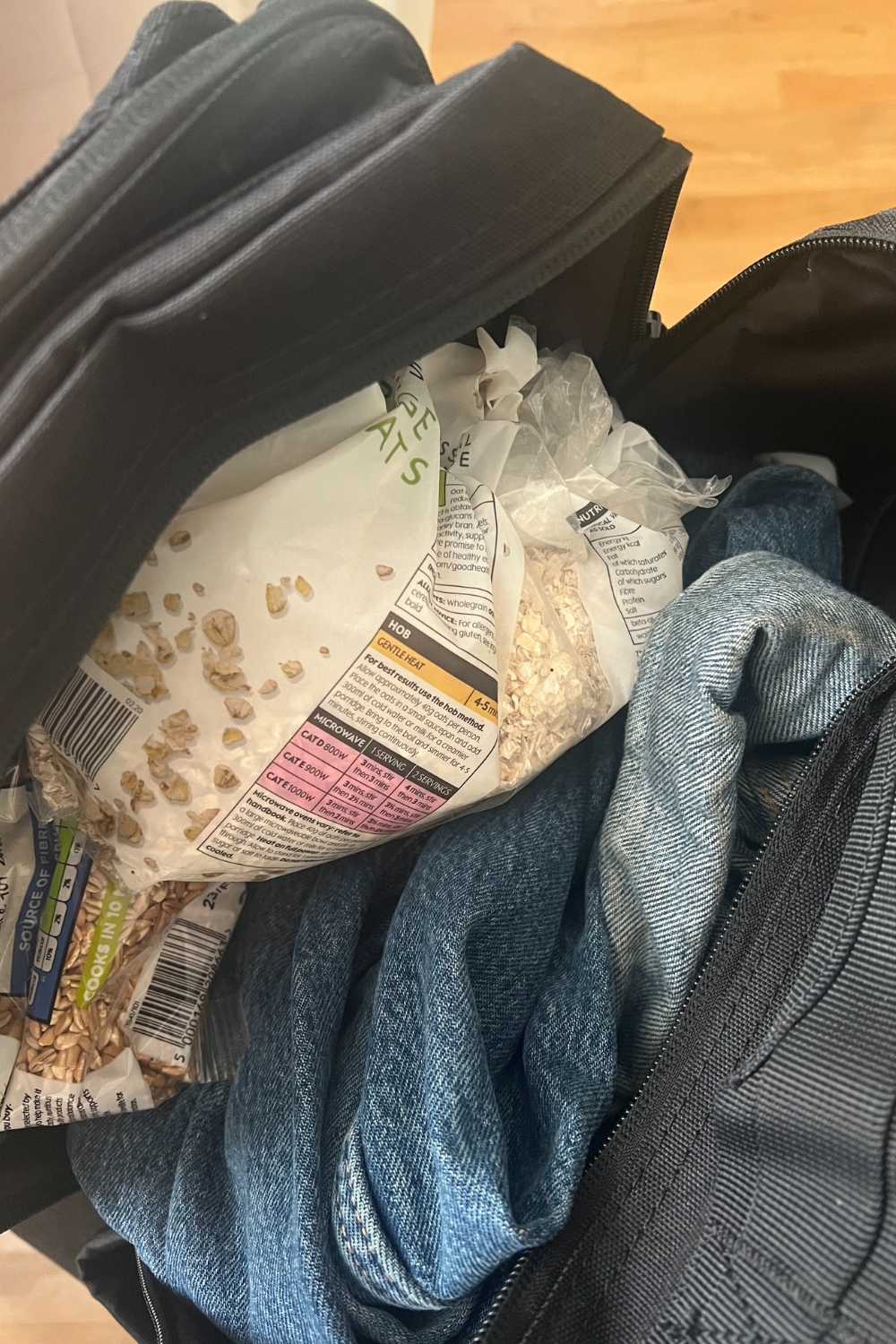
If you're a fan of weight training but have been struggling to get to the gym regularly, you might be feeling a little low on fitness motivation. Don't worry - we're all for workouts that fit into your daily lifestyle here at Marie Claire UK and don't require hour-round gym trips. Which is why, when we saw rucking - the latest TikTok workout trend - doing the rounds, we wanted to hear more.
Never heard of it and unsure what it means? If you're not familiar with military terms, rucking describes a walk where you add weight (think a rucksack or weighted vest). While the concept originated from early military practices, it's now hugely popular on TikTok with a casual near 22 million views and has been adopted by personal trainers and formulated into a simple to do, low intensity workout with a twist.
Strength training for beginners seems to be the sweat session of the moment, but rucking takes things up a notch, combining weight training with a cardiovascular workout, too. Wondering whether it's good for you? There's plenty of research to prove the efficacy of merging cardio and strength training - various clinical trials conducted to support have concluded it a great way to boost muscle tone, strength, heart health, and overall fitness, so much so the NHS website actually advises you do both cardio workouts and strength training every week.
Plus, just a few months ago, The University of Florida published this study that suggests that participants who incorporated both aerobic exercises had better cognitive ability, too - in other words, they were quicker thinkers and had greater ability to adapt their thinking.
It's pretty hard to find a workout that's low intensity - in other words, kind to your joints - and boosts both strength and cardio, so I decided to test it out for two weeks to see if it's deserving of the hype. Keep scrolling to see how I got on and see what the experts have to say on the new trend, and don't miss our guides to strength training every other day, low impact strength training, and home workouts that build muscle, while you're here.
Rucking is trending - so I tried it for two weeks
What is rucking?
In short, rucking is a variation of walking that incorporates a more rigorous element in the form of a weighted rucksack or vest.
Personal trainers maintain that adding weight to your walks can be a great way to take the low intensity workout up a notch without investing in weights or workout equipment you might not use in the long run.
“Rucking encompasses all the benefits of a daily walk, such as cardio, fresh air and sunlight but with the addition of extra resistance,” explains Aimee Cringle, CrossFit athlete. "This will help to improve your endurance and stamina.”
What are the benefits of rucking?
Rucking is a great option for those of you who are keen to get a good workout in without investing in loads of kit. Not to mention, it's easy to tailor to your energy levels and time restrictions - you can vary your weight each time or add a touch of more intensity depending on the walking route you choose.
One of the biggest plus points of the workout is that it allows you to combine both strength training and cardio, plus as the athlete highlights, it's a great way to improve your fitness levels quickly. If you incrementally increase the weight you're carrying, you'll be creating a progressive overload, in turn boosting both your strength and overall health.
Lucie Cowan, master trainer at Third Space, agrees, adding: "Rucking is a great low-intensity cardiovascular workout, improving both your heart health and endurance over time." She shares that the other benefits span:
@jettifit ♬ Do It Better - Beachcrimes & Tia Tia
1. It's a full body workout
Rucking engages various muscle groups, including your legs, core, and upper body, she shares. "This provides a complete workout without the need for high-impact exercises," she continues.
If you have sensitive joints or would rather be mindful of stress session that'll overload your body, rucking is a great option for you. "Rucking is gentle on the joints compared to high-impact exercises, making it suitable for individuals of all fitness levels and ages," the trainer adds.
2. It'll lower your stress
As well as boosting your physical health, rucking promises to lower your stress levels and improve your mental health, too.
"Being in nature and taking a brisk walk with a weighted pack has been shown to reduce stress and improve mental well-being," she explains.
3. It's good for your posture
Many of us spend hours hunched over a desk at work, yet rucking promises to improve your posture in a simple and cost-effective way.
"Carrying a backpack encourages better posture," details Cowan. "This can be beneficial for those of you who spend a lot of time sitting or using smartphones."
4. It's versatile
One of the best things about rucking is its versatility, shares the trainer.
"It can be tailored to your individual fitness levels by adjusting the weight and distance," she explains. "This makes it a really versatile option for anyone and varying goals."
5. It's convenient and community-focused
Last but by no means least, rucking is one of the simplest workouts you can do as it can be done almost anytime, any place. "This means you can easily incorporate it into your daily routine, whether it's during a lunch break or a holiday hike," Cowan adds.
Not to mention, rucking can be a really great group activity, fostering a sense of community and social interaction. "It combines working out and time with friends or family, plus could provide an opportunity to meet new like-minded people," she concludes.
@karissa.sparke ♬ greedy - Tate McRae
How much weight should I start with?
Despite its low-intensity nature, there are still some precautions that should be taken into consideration if you're thinking of giving it a go. New to rucking? Start by practising walking with an empty backpack to simulate weight. Then, when you feel comfortable start implementing weight. Cringle shares that beginners should aim to start with five to ten per cent of their body weight.
It's also important to invest in a well-fitted backpack to prevent injuries, shares Cowan. Her key suggestion is to opt for a high-quality backpack and evenly distribute the weight (top tip: look for adjustable straps to personalise the fit).
A pro tip from Pitt Grewe, Head of Public Land Partnerships at AllTrails, is to maintain proper posture. Not sure what this looks like? You'll be helped by taking smaller steps on steep descents, utilise trekking poles, wearing supportive footwear, and listening to your body by taking breaks and avoiding overexertion.
Cowan suggests focusing on keeping your back straight, shoulders back, and head up. "Most importantly, brace your core when a heavy backpack is on, as this pulls you backwards, often leading to lower back strain if the core muscles are not properly engaged," she says.
Grewe agrees and adds: “It’s important to pace yourself and understand your fitness level while choosing trails that align with your capabilities. Remember, you are not trying to find your max - it's all about steady consistent movement under load. Take breaks when needed and listen to your body.”

"I tried rucking for two weeks - and am a convert."
Day one and I was prepared to give it a go. As Cowan suggested, I started with a trial run to make sure the weight I was using was comfortable and safe. I loaded various items I found in my house, from books to water bottles filled with rice, in order to measure up to 5% of my weight.
With my backpack securely strapped, I headed out. To my surprise, I started to notice the added weight just five minutes in. That said, it didn't feel unbearable or uncomfortable - rather, spicy and challenging, but in a good way.
I'd originally set out to do a quick 15 minutes after work, but found it so enjoyable that I ended up pushing it to 30 minutes. While the weight felt evenly distributed in my bag, I did notice that some of the books were poking my back, so made a mental note to rethink the items I packed for my next walk.

For my second workout, I replaced the books with softer items like pairs of heavy denim trousers and bags of rice, oats, and spelt. Slowly but surely, I felt more confident with the weight I was carrying (case in point: towards the end of the two weeks was able to get up to a 10% increase in the weight I was carrying).
Come the end of week one and I'm pleasantly enjoying the new challenge. It doesn't take up tonnes of time and gives you plenty of time to appreciate nature, something you don't get if you're weight lifting in a gym. I was pleasantly surprised with how much rucking boosted my mental as well as physical health, something I hadn't anticipated before starting the workout challenge.
Week two and while I struggled to fit all of my workouts in - I love running, strength training, and the occasional Pilates session - I reminded myself to go gently. Replacing my normal runs with rucking meant I was embracing more low impact workouts and my hips definitely thanked me for it.
Come workout two of week two, I realised that I could increment the weight I was carrying and practice progressive overload as the trainers had explained. This boosted my physical health and my mental health, too - it made me feel more confident seeing my body being able to carry more weight during my walks.
Did I feel any strain on my body? Slightly. Taking the advice I received from the experts, I tried my hardest to activate my core when rucking, but as expected, forgot from time to time. My body wasn’t particularly used to carrying extra weight when walking uphill, but I felt really confident when I was able to overcome the extra challenge. This is why I increased the weight slowly during the testing process so as not to compromise my form or risk injury.
Throughout the two weeks, I did have one or two sessions that felt too challenging as thought they might be straining my lower back. During these sessions, I'd either cut my session short or make my way back home to reduce the weight I was carrying - it's always important to listen to your body, after all. As impractical as doing this was, it encouraged me to mindfully connect with both my body and mind, something we so often forget to do.
Will I continue rucking?
I love workouts that make both my mind and body feel good and give me an opportunity to enjoy nature and fresh air, so I'll definitely continue rucking. I found it seriously simple yet effective, too, and I definitely felt stronger after my short two week test.
As with every workout I test and take on, I always like to make sure I remember the "why" I do it. For me, this was a simple and cost-effective way to improve both my strength and cardio fitness and, as Deanna Brash of Bodyism points out, it's also a great workout for improving your function fitness (in other words, your ability to carry out day-to-day tasks with ease and without pain). “If you're off on a lovely walking holiday which requires you to carry your luggage and tent with you, then it may be beneficial to build up your strength and endurance in advance," she shares.
That said, if you're simply trying it to be part of the TikTok trend, it might be better to take the time to figure out a workout you genuinely enjoy and will stick to. "If you're only doing it because the trend said so, there are probably better workout modalities you could be doing instead to support your goals.”
While I might not continue the workout as regularly as I did during testing, I can already see it benefiting me during those days when I crave a low intensity workout. Now, question: will you be giving it a go?
Shop MC UK's rucking essentials now:
All that walking is bound to work up a sweat, and we're big fans of Wild deodorant here at MC UK. Made from aluminium, the cases are planet-friendly, reusable and designed with refill in mind. Plus, every case sold results in two trees being planted. Senior Health Editor Ally Head's go-to refill is the orange and neroli - a fresh, vibrant scent.







